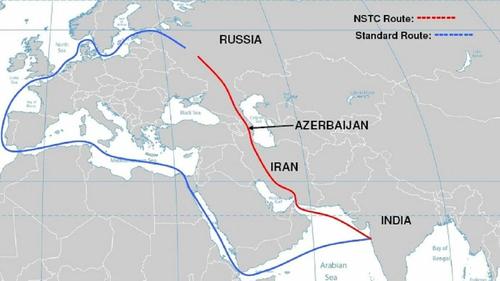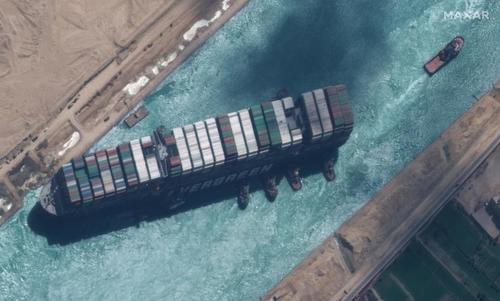Iran Touts Russia-Iran-India ‘North-South Trade Corridor’ As “Alternative” & Challenge To Suez Canal
Coming after a ‘successful’ weekend in which sanctions-beleaguered Iran hailed its signing a major 25-year infrastructure and investment agreement with China, Iran’s ambassador to Russia is also touting that a new north-south trade corridor across the region could become a prime ‘alternative’ to the strategic Suez Canal waterway that’s been featured in global headlines due to the ‘Ever Given’ stuck tanker disaster that just played out.
Called the “International North-South Transport Corridor (INSTC)” — a two decades in the making ambitious project — the new trade corridor, currently partially in operation, is 7,200km long, linking up Russia, Iran, and India and ultimately accelerating trade with Europe as well.
Commenting on the stuck tanker fiasco in the Suez, Iranian Ambassador Kazem Jalali explained of a potentially less expensive and disaster-prone waterway transport route across Egypt:
“The North-South corridor is a great option to replace the Suez Canal with a reduction in travel times to 20 days and savings of up to 30 percent.”
He further described that the mounting huge costs and fallout from the Ever Given jam disaster (commonly ballparked in the many multiple billions) demonstrates “the need to speed up the completion of infrastructure and the North-South corridor as an alternative to the route through the Suez Canal has become clear and more important than ever.”
A regional analysis site, Silk Road Briefing, reviews the recent history of the project as follows:
The INSTC project came into being in 2002, when the transport ministers of Russia, Iran, and India signed an agreement to create a multimodal ship, rail and road-based transport network stretching 7,200 km, from Mumbai, western India to Moscow via Iran and the Caspian Sea. Since then, Azerbaijan, Armenia, Belarus, Kazakhstan, Tajikistan, Kyrgyzstan, Ukraine, Oman, and Syria have all joined the project, and new routes via Azerbaijan and Central Asian countries have been examined to eliminate the need to transfer cargoes from overland-based transport to cargo ships and back…
The claims of reduced transport travel time and cost are often advanced according to these estimates:
The INSTC corridor has been tested, and cuts current transport costs by between 30-60 percent, in addition to reducing the transit time from west India to western Russia from 40 to 20 days. Dry runs of the route carried out in 2014 and 2017 identified potential bottlenecks and confirmed cost and shipping time estimates.
Will Iranian sea corridor compete with Suez Canal? https://t.co/gMSuAUW61r
— Al-Monitor (@AlMonitor) July 17, 2020
It’s been dubbed in Russian media, even long before the latest Suez crisis, a challenge to the Suez canal.
Also sometimes compared to the ancient ‘Silk Road’ (the most famous East-West trade route across Asia from antiquity through the Middle Ages) – and somewhat akin to China’s expanding Belt & Road initiative under President Xi, it primarily by rail links two major bodies of water – the Indian Ocean and Persian Gulf – by way of Iran to Russia and northern Europe.
Tyler Durden
Tue, 03/30/2021 – 23:05
via ZeroHedge News https://ift.tt/3sDB7fI Tyler Durden

